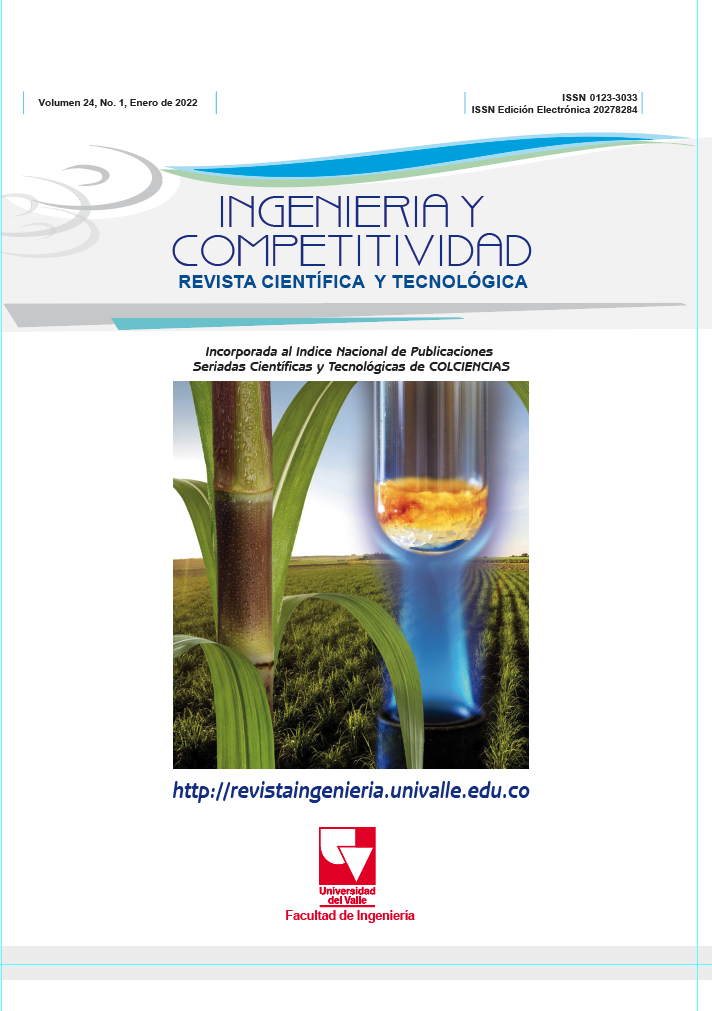Evaluación ambiental asistida por computador del proceso de producción de hidromiel a escala piloto en el Departamento de Boyacá y Bolívar (Colombia)
Contenido principal del artículo
El desarrollo de procesos y actividades industriales que promueven el crecimiento sostenible de la cadena de producción apícola se ha vuelto muy importante en los últimos años. Hidromiel o mead es el nombre dado a un tipo de vino que se produce a partir de la fermentación alcohólica de la miel de abejas diluida; es una de las bebidas más antiguas y apetecida en el norte de Europa. En Colombia, la producción de hidromiel se da a pequeña escala. En este trabajo se evaluaron los impactos ambientales asociados a una planta existente de hidromiel ubicada en el Municipio de San Mateo Boyacá. Adicionalmente, se valoraron los posibles impactos que se generarían en el momento de implementar una planta de producción en el Departamento de Bolívar. El análisis se realizó usando la herramienta de diagnóstico WARGUI, un software de código abierto que permite evaluar tanto los impactos producidos como los consumidos por el proceso, en 8 categorías diferentes. Esta herramienta permitió realizar un estudio y presentar alternativas relacionadas con el uso de combustibles y residuos, información que contribuye a mejorar la sostenibilidad del proceso. Los resultados que se destacan son que no se presentó una diferencia considerable entre los impactos ocasionados al ambiente de la planta piloto de Boyacá y la simulada del Departamento de Bolívar y, que en general, ambas plantas presentaron un comportamiento sostenible desde el punto de vista ambiental.
- Análisis ambiental
- Algoritmo WAR
- Hidromiel
(1) Minciencias. Colombia, el segundo país más biodiverso del mundo | MINCIENCIAS [Internet]. Colombia: Minciencias. 2016 [cited 2019 Feb 14]. 3. Available from: https://minciencias.gov.co/sala_de_prensa/colombia-el-segundo-pais-mas-biodiverso-del-mundo.
(2) SIOC. Apicola [Internet]. 2021 [cited 2021 Jun 15]. Available from: https://sioc.minagricultura.gov.co/Apicola/Pages/default.aspx
(3) Quicazán M, Cuenca M, Paz A. Producción de hidromiel en el contexto de la apicultara en Colombia. Primera edicion. Bogotá: Universidad Nacional de Colombia. Facultad de Ciencias Agraria. Centro Editorial; 2017.
(4) Apisred. APISRED | Producción de Miel en Colombia | Apicultura en Colombia: - Productos Derivados [Internet]. 2019. 2019 [cited 2019 Feb 14]. Available from: https://www.apiculturaencolombia.com/website/productos/productos-derivados
(5) Nieto M. La responsabilidad social de la organización una herramienta para el desarrollo sostenible. In: Izarra D, editor. Experiencias y perspectivas en ética profesional y responsabilidad social universitaria en Iberoamérica. San Cristobal: BNC; 2016. p. 142–62.
(6) Gonzalez-Delgado AD, Parejo V, Herrera T. Computer-aided environmental evaluation of bio-hydrogen production from residual biomass of palm cultivation. Contemp Eng Sci. 2017;10(16):773–83 https://doi.org/10.12988/ces.2017.7770.
(7) Herrera-aristizábal R, Salgado-dueñas JS, Peralta-Ruiz YY, Gonzalez-Delgado AD. Environmental Evaluation of a Palm-based biorefinery under North-Colombian Conditions. Chem Eng Trans. 2017;57:193–8. https://doi.org/10.3303/CET1757033
(8) Meramo-hurtado S, Ojeda-delgado K, Sánchez-Tuirán E. Environmental Assessment of a Biorefinery : Case Study of a Purification Stage in Biomass Gasification. 2018;11(3):113–20 https://doi.org/10.12988/ces.2018.813.
(9) Cardona CA, Marulanda VF, Young D. Analysis of the environmental impact of butylacetate process through the WAR algorithm. Chem Eng Sci. 2004 Dec 1;59(24):5839–45 https://doi.org/10.1016/j.ces.2004.06.043
(10) Ramirez-cando LJ, Spugnoli P, Matteo R, Bagatta M, Tavarini Si, Foschi L, et al. Environmental Assessment of Flax Straw Production for Non-. 2017;58:787–92. https://doi.org/10.3303/CET1758132.
(11) Chakana. El vino “responsable”: huella de carbono e impacto ambiental [Internet]. Argentina: Chakana. 21/04/2017. [cited 2021 May 30]. Available from: https://www.chakanawines.com.ar/blog/el-vino-“responsable”:-huella-de-carbono-e-impacto-ambiental
(12) Montoya MI; Quintero JA; Sánchez OJ; Cardona CA. Simulación de los procesos de obtención de etanol a partir de caña de azúcar y maíz. Scientia et Technica. 2005;28(2):187-92. Available from: https://revistas.utp.edu.co/index.php/revistaciencia/article/view/6859.
(13) Pronóstico del tiempo y condiciones meteorológicas para San Mateo, Boyacá: The Weather Channel | Weather.com [Internet]. The weather channel. 2021 [cited 2021 Feb 10]. Available from: https://weather.com/es-CO/tiempo/hoy/l/6.40,-72.55?par=google&temp=c
(14) Godoy M, Espinoza B. INCIDENCIA DEL CALENTAMIENTO GLOBAL EN LA FLORA Y FAUNA DEL ECUADOR. Desarro local Sostenible [Internet]. 2018 [cited 2021 Feb 10]; Available from: https://www.eumed.net/rev/delos/31/Maria-Godoy-calentamiento.html
(15) Sánchez OJ, Cardona CA, Sánchez DL. Análisis de ciclo de vida y su aplicación a la producción de bioetanol: Una aproximación cualitativa. Rev Univ EAFIT. 2007;43(146):59–79. Available from: https://publicaciones.eafit.edu.co/index.php/revista-universidad-eafit/article/view/773.
(16) Montoya R M, Quintero S J, Sánchez T Ó, Cardona A C. Environmental impact assessment for ethanol production process using the waste reduction algorithm. Rev Fac Ing Univ Antioquia. 2006;(36):85–95. Available from: https://revistas.udea.edu.co/index.php/ingenieria/article/view/343247.
(17) Ojeda KA, Herrera AP, Sierra MJ, Tamayo K. Evaluación del impacto ambiental del uso de nanopartículas de alúmina como aditivo de mezclas biodiesel/diésel mediante análisis de ciclo de vida. Ing Y Compet. 2015;17(1):133–42. https://doi.org/10.25100/iyc.v17i1.2208.
(18) Granados Sánchez D, López Ríos GF, Hernández García MÁ. La Lluvia Ácida Y Los Ecosistemas Forestales. Rev Chapingo Ser Ciencias For Y Del Ambient. 2010;16(2):187–206. http://dx.doi.org/10.5154/r.rchscfa.2010.04.022
(19) Camargo Y, Bolaño T, Alvarez A. Emisiones de compuestos orgánicos volátiles de origen biogénico y su contribución dinámica atmosférica. Intropica. 2010;5(1):77–86. Available from: https://revistas.unimagdalena.edu.co/index.php/intropica/article/view/155.
Descargas

Esta obra está bajo una licencia internacional Creative Commons Atribución-NoComercial-CompartirIgual 4.0.
Los autores que publican en esta revista están de acuerdo con los siguientes términos:
Los autores ceden los derechos patrimoniales a la revista y a la Universidad del Valle sobre los manuscritos aceptados, pero podrán hacer los reusos que consideren pertinentes por motivos profesionales, educativos, académicos o científicos, de acuerdo con los términos de la licencia que otorga la revista a todos sus artículos.
Los artículos serán publicados bajo la licencia Creative Commons 4.0 BY-NC-SA (de atribución, no comercial, sin obras derivadas).





